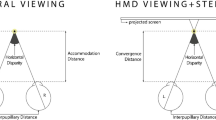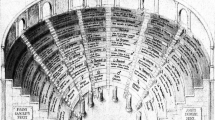Abstract
This study presents a 3D virtual reality (VR) keyboard system with realistic haptic feedback. The system uses two five-fingered data gloves to track finger positions and postures, uses micro-speakers to create simulated vibrations, and uses a head-mounted display (HMD) for 3D display. When users press a virtual key in the VR environment, the system can provide realistic simulated key click haptic feedback to users. The results of this study show that the advantages of the haptic VR keyboard are that users can use it when wearing HMDs (users do not need to remove HMDs to use the VR keyboard), the haptic VR keyboard can pop-up display at any location in the VR environments (users do not need to go to a specific location to use an actual physical keyboard), and the haptic VR keyboard can be used to provide realistic key click haptic feedback (which other studies have shown enhances user performance). The results also show that the haptic VR keyboard system can be used to create complex vibrations that simulate measured vibrations from a real keyboard and enhance keyboard interaction in a fully immersive VR environment.













Similar content being viewed by others
References
Aoki T, Mitake H, Keoki D, Hasegawa S, Sato M (2009) Wearable haptic device to present contact sensation based on cutaneous sensation using thin wire. Proceedings of the International Conference on advances in computer entertainment technology, Athens, Greece, 29–31 October, pp 115–122
Bensmaïa S, Hollins M, Yau J (2005) Vibrotactile intensity and frequency information in the Pacinian system. A psychophysical model. Percept Psychophys 67(5):828–841
Chaparro BS, Phan MH, Siu C, Jardina JR (2014) User performance and satisfaction of tablet physical keyboards. J Usability Stud 9(2):70–80
Choi K-S, Lo K-H (2014) A virtual reality training system for helping disabled children to acquire skills in activities of daily living. The 14th International Conference on computers helping people with special needs (ICCHP 2014), Paris, France, 9–11 July, pp 244–251
De Pra Y, Fontana F, Tao L (2014) Infrared vs. ultrasonic finger detection on a virtual piano keyboard. Proceedings of the 2014 international computer music conference (ICMC), Athens, Greece, 14–20 September, pp 654–658
Du H, Charbon E (2008) A virtual keyboard system based on multi-level feature matching. Conference on human system interactions, Krakow, Republic of Poland, 25–27 May, pp 176–181
Fukumoto M, Sugimura T (2001) Active click: haptic feedback for touch panels. Proceedings of Extended Abstracts on human factors in computing systems, Seattle, Washington, USA, 31 March–5 April, pp 121–122
Hashimoto Y, Nakata S, and Kajimot H (2009) Novel haptic display for emotional haptic experience. Proceedings of the International Conference on advances in computer entertainment technology, Athens, Greece, 29–31 October, pp 124–131
Hayward V, Cruz-Hernandez M (2000) Haptic display device using distributed lateral skin stretch. Proceedings of the haptic interfaces for virtual environment and teleoperator systems symposium, 5–10 November, pp 1309–1314
Kim S, Kim GJ (2004) Using keyboards with head mounted displays. Proceedings of the 2004 ACM SIGGRAPH, Singapore, Singapore, 16–18 June, pp 336–343
Koskinen E, Kaaresoja T, Laitinen P (2008) Feel-good touch: finding the most pleasant haptic feedback for a mobile touch screen button. Proceedings of the 10th International Conference on multimodal interfaces, Chania, Crete, Greece, 20–22 October, pp 297–304
Kyung K-U, Son S-W, Kwon D-S, Kim M-S (2004) Design of an integrated haptic display system. IEEE International Conference on robotics and automation, New Orleans, LA, USA, 26 April–1 May, pp 7766–7781
Lylykangas J, Surakka V, Salminen K, Raisamo J, Laitinen P, Rönning K, Raisamo R (2011) Designing haptic feedback for piezo buttons. Proceedings of the SIGCHI Conference on human factors in computing system, Vancouver, BC, CANADA, 7–12 May, pp 3281–3284
Markov-Vetter D, Moll E, Staadt O (2012) Evaluation of 3D selection tasks in parabolic flight conditions: pointing task in augmented reality user interfaces. The 11th ACM SIGGRAPH International Conference on virtual-reality continuum and its applications in industry, Singapore, 2–4 December, pp 287–294
Minamizawa K, Fukamachi S, KajimotoH, Kawakami N, Tachi S (2007) Wearable haptic display to present virtual mass sensation. Proceedings of ACM SIGGRAPH 2007, San Diego, California, USA, 5–9 August, Article No 43
Olsson P, Johansson S, Nysjö F, Carlbom I (2012) Rendering stiffness with a prototype haptic glove actuated by an integrated piezoelectric motor. International Conference, EuroHaptics 2012, Tampere, Finland, 13–15 June, pp 361–372
Park G, Choi S, Hwang K, Kim S, Sa J, Joung M (2011) Haptic effect design and evaluation for virtual buttons on a mobile device touchscreen. Proceedings of the 13th International Conference on human computer interaction with mobile devices and services, Stockholm, Sweden, 30 August–2 September, pp 11–20
Romano JM, Kuchenbecker KJ (2012) Creating realistic virtual textures from contact acceleration data. IEEE Trans Haptics 5(2):109–119
Smith S, Smith GC, Lee JL (2015) The effects of realistic tactile haptic feedback on user surface texture perception. J Vibro Eng 17(2):1004–1016
Sziebig G, Solvang B, Kiss C, Korondi P (2009) Vibro-haptic feedback for VR systems. Proceedings of the 2nd conference on human system interactions, Catania, Italy, 21–23 May, pp 403–407
Tashiro K, Shiokawa Y, Maeno T (2009) Realization of button click feeling by use of ultrasonic vibration and force feedback. EuroHaptics Conference and Symposium on haptic interfaces for virtual environment and teleoperator systems. World Haptics 2009, Third Joint, Salt Lake City, UT, USA, 18–20 March, pp 1–6
Tzafestas C, Birbas K, Koumpouros Y, Christopoulos D (2008) Pilot evaluation study of a virtual paracentesis simulator for skill training and assessment: the beneficial effect of haptic display. Presence: Teleoper Virtual Environ 17(2):212–229
Wu Y, Schmidt L, Parker M, Strong J, Bruns M, Ramani VK (2012) Active-hand: automatic configurable haptic interaction in virtual environment. IDETC/CIE 2012, Chicago, IL, USA, 12–15 August, pp 1481–1490
Smith, S., Smith, G.C., Lee, J.L. (2015) The effects of realistic tactile haptic feedback on user surface texture perception. Journal of Vibroengineering 17(2):1004-1016
Acknowledgments
The authors would like to thank the Ministry of Science and Technology of Taiwan for providing support for this research under Contract MOST 104-2221-E-002 -066 -MY2.
Author information
Authors and Affiliations
Corresponding author
Rights and permissions
About this article
Cite this article
Wu, CM., Hsu, CW., Lee, TK. et al. A virtual reality keyboard with realistic haptic feedback in a fully immersive virtual environment. Virtual Reality 21, 19–29 (2017). https://doi.org/10.1007/s10055-016-0296-6
Received:
Accepted:
Published:
Issue Date:
DOI: https://doi.org/10.1007/s10055-016-0296-6




